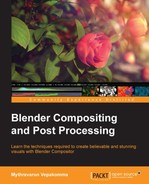This chapter explains the node-based architecture of Blender Compositor, linear workflow, and user interface panels. Following is the list of topics covered in this chapter:
- Node-based architecture
- Types of compositing nodes
- Node Editor
- UV / Image Editor
- Color management and linear workspace
Blender Compositor is built on an efficient node-based architecture. Every transformation tool in Blender Compositor is defined as a node, building a directed acyclic graph (DAG) from source input to output image. This process of building graphs using individual transformation tools is termed as node-based workflow. This architecture provides flexibility to tweak parameters procedurally. The connectors that connect these individual nodes are called noodles.
Every individual node performs a specific operation, and many such nodes are linked progressively to form a compositing flow. These nodes can be classified into three categories based on the functional similarities:
